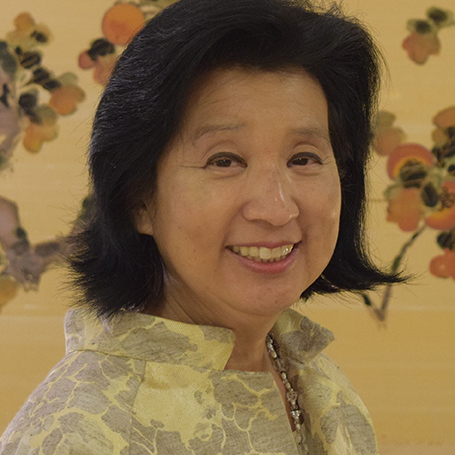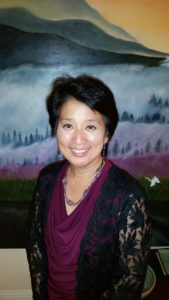DIRECTOR’S REPORT 2019-20
We have seen unprecedented changes in the world with our climate and in our geopolitics in recent years. In the news, we have witnessed a flood of migrants and asylum seekers to our borders, with a rush to demonize the humanity crossing into the States. In addition, presidential executive orders banning refugees from certain Muslim nations, was upheld by the U.S. Supreme Court, even invoking the specter of Korematsu. How could this happen? The spike of migrant crossings at our southern borders and the severity to which minors were being separated from their parents, many were being detained indefinitely, alarmed our sense of decency. What is happening here?
For some in the Japanese American community who remember, the treatment of the border crossers has stirred up traumatic childhood memories of their own family separation 78 years ago. Soon after the bombing of Pearl Harbor, the children of Issei leaders witnessed their fathers and some mothers being hauled away by the FBI to jail and eventually to Department of Justice internment camps- as “dangerous persons.” The experience of such a profound sense of confusion, loss, and dislocation is forever etched in their psyche. Why did this happen? What was their crime?
As our community grapples with these questions, NJAHS continues to grow our programming on the Japanese American experience, past and present. We teamed up with the Jonathan Logan Family Foundation, Futures Without Violence, the Fred T. Korematsu Institute, the Alphawood Gallery, and J-Sei to sponsor an exhibition Then They Came for Me: Incarceration of Japanese Americans during WWII & the Demise of Civil Liberties. Our curatorial team mounted the display with local objects, docent training, & teacher workshops to educate the public about then and now.
Our current issue of Nikkei Heritage explores the WWII Enemy Alien Program. We are encouraged by the teachers hungry for relevant lesson plans that explore this history and its themes. With support from the Japanese American Confinement Sites-NPS grant program, we have conducted our Department of Justice Internment Teacher Education workshops in Santa Fe & Las Cruses, NM, Honolulu, HI, Chicago, IL, Bismarck, ND, Twin Cities, ID. We also further developed exhibit installations for Dislocations and Divergence: Causes & Consequences of E.O. 9066 at the MIS Historic Learning Center.
Working closely with our University of San Francisco partner, NJAHS digitized our military collections and our oral history collections, accessioned since the 1980s for greater public access. As part of our public engagement activities, we participated in the 150th celebration of the Wakamatsu Colony, presented genealogy workshops for the community, celebrated our Nisei veterans at the MIS Historic Learning Center, and highlighted filmmakers and activists who made a difference through truth-telling. In the coming year, we are pleased to introduce for the first time artifacts from guest curator Nancy Ukai’s The 50 Objects Project, and to present through a contemporary lens, Canadian photographer Kayla Isomura’s The Suitcase Project. Thank you for joining us on our mission to collect, preserve, authentically interpret, and share historical informaiton on the Japanese American experience. NJAHS is very honored by our growing community of supporters during these challenging times.
DIRECTOR’S REPORT 2018
This year in 2018, NJAHS commemorates the 30th anniversary of the Civil Liberties Act of 1988 (the Redress bill). However, we are devoting this issue of Nikkei Heritage (Fall 2017/Spring 2018, Vol. 27, No. 1) to the meaning of Executive Order 9066 because it remains timely.
Last year was one of incredible change and deep reflection. While marking EO 9066’s 75th anniversary, we witness the roll out of a series of presidential executive orders on immigration bans, mostly on Muslim-majority countries. Are we at war? Who is the enemy? Is there a military necessity? These were some of the questions asked.
As these executive orders wind their way through the Circuit Court of Appeals, and all the way up to the Supreme Court, we have an opportunity to take a look back in time and examine what CO 9066 meant for Japanese Americans. When we present the World War II incarceration experience to our tour groups at our Japantown and MIS Historic Learning Center galleries, and at our teacher education workshops, we find that most people know little about its causes and intent.
We’ve invited Wes Nihei, a NJAHS docent and former magazine editor, and Naomi Shibata, also a NJAHS docent, our senior engagement writing instructor, and editor of Bend With the Wind, to help us assemble this special issue.
Last year, NJAHS produced and advised several exhibitions, including art and artifacts from our collections, to remember EO 9066 such as SOMETHING FROM NOTHING (in collaboration with University of San Francisco’s Thacher Gallery, Museum Studies and Art Departments). At the Presidio, we displayed CHILDREN OF THE CAMPS & ARTISTS EYES: ART OF INCARCERATION. Yet, we wanted to offer our members something more–a simple FAQs sheet to help inform your discussion and understanding. We researched and wrote the questions and answers you will read in the first part of the issue.
We also wanted to convey the personal effects of WWII on families and knew that there was no better way to tell the stories than my those who lived through it. In the second half, you will read in “Memories of World War II” the thoughts, feelings, and writings of that time period from seniors who lived through it, elicited by Naomi in our senior engagement program, supported by the JA Community Foundation and the Los Angeles Public Library.
In addition at our new interpretative center, the MIS Historic Learning Center at the Presidio of San Francisco, we have a newly installed WWII detention mock-up horse stall barrack, comprehensive Camp map and an interactive kiosk for records search. When you visit, you can navigate the camp map and dive deeper into the collections, and oral histories. This project is funded in part by grants from the Japanese American Confinement Sites, administered by the National Park Service.
At the Post Street Peace Gallery, an exhibit on the 50th anniversary of the SF Japantown Peace Plaza and Peace Pagoda will be on display by the Nihonmachi Street Fair (August 4, 5). Generous support from the Henri & Tomoye Takahashi Charitable Foundation has made this and our 2018 public programming possible.
DIRECTOR’S REPORT 2016
It was common occurrence growing up in an all-white neighborhood, that I would be asked, “Who are you? Where did you come?” When my pat answer “Los Angeles” was not enough to satisfy their curiosity, they would persist, “No, really, where did you come from, your ancestors? Annoyed by being singled out as identifiably different from my peers, I grew to resent these questions about my identity. Fast forward to today, in the Bay Area where multicultural families are common, such inquiries are usually cordial guessing games. “Hey, are you Japanese American? Are you part Chinese? Are you hapa?” I’m not so bothered by the questions. I suppose it depends on the context of how I am asked and who is doing the asking.
In the context of the presidential campaigns, the rancor and fear-mongering over people’s national origin, ethnicity or religion is a tactic nothing less than political scapegoating. They are not too different from school yard bullying. We’ve seen it time and time again; we’ve also experienced it personally and collectively as Japanese Americans. The vestiges of wartime hysteria and racial prejudice creep into the political arena and become a toxic mix igniting a fear of and hatred toward others.
It was after all, race prejudice, wartime hysteria and failure of political leadership that led to the egregious incarceration of Japanese Americans during WWII. The government acknowledged its grave mistake with redress and reparations as well as funding for civil liberties educational initiatives to begin to set the record straight. But did it? Even today, we find the same misrepresentations about the justification for camps for Syrian refugees or Muslim Americans being resurrected in the political discourse.
As Japanese Americans, we need to step up and set the record straight. That is why in coalition with other Muslim and Arab American civic groups, the Bay Area Day of Remembrance Committee held a press conference to clarify what occurred historically and to combat the toxic mixture of fear and hate directed at innocent members of the Arab, Middle Eastern, Muslim, and South Asian communities.
Just as it is NJAHS’ mission to share the Japanese American experience as part of the larger American narrative, it should be every Japanese American’s responsibility to aid in that effort by speaking up and being heard. By doing so, we help shape that American historical narrative.
NJAHS continues to keep a busy pace in the coming year. Teaching the next generation continues to be our priority at our office and museum in San Francisco’s Japantown and at the Military Intelligence Service Historic Learning Center in the Presidio of San Francisco. Under the direction of Dr. Grace Morizawa, and NJAHS Program Development Associate Melissa Ayumi Bailey, our regional ties and our newly developed historic-inquiry and place-based curriculum is now accessible on-line. As part of the National Veterans Network, we are working with the Smithsonian Institution to bring the little known story of the Nisei soldier to light through an interactive online website.
We are strategically re-designing the space for our site in Japantown to create a more accessible visitor-friendly experience that helps re-vitalize Japantown. In this 110th commemorative year for SF Nihonmachi, we look toward new ways to promote “this great place to be” with social media and creative audience engagement. Speaking of accessibility, we are undertaking our most ambitious project to date: digitizing much of our WWII camp collections of documents, manuscripts, videos, audio tapes under the direction of Project Manager Paloma Anoveros and Exhibition and Collections Manager Max Nihei, who recently completed his Masters in Museum Studies at the University of San Francisco.
Our loyal and supportive board members make us proud to be a part of NJAHS. And without a doubt, we appreciate our our enduring members and supporters, volunteers and interns for their strong support. I am most grateful for your steadfast belief that we are making a difference in this world.
DIRECTOR’S REPORT
Everyone’s has their ups and downs. What I’ve learned over the years working with our elders, is that when you have rain, you will have sunshine, when there is war, there is peace, sometimes you just change the lens. It’s that sense of optimism and promise that I’ve seen in a generation that has lived through so much.
George Yoshida wrote in his seminal book on Japanese Americans and music, Reminscing in Swingtime, “Artists are healers—youthful Nisei provided the balm to disheartened souls,” when referring to those youngsters who created dance bands in the camps. Amid the desolation of camp life, Japanese Americans found hope in their own musical expressions. It was a matter of survival for many, and a natural movement in the acculturation of the Nisei- an affirmation of their identity as American youth.
Editor Ben Hamamoto, takes it a step and a generation or two further. With a featured tribute to the “hipster” musician & author George Yoshida, and ethnomusicologist Anthony Brown, Hamamoto reveals the life’s work of these two “greats.” Along the continuum, Hamamoto presents Professor Loren Kajikawa’s perspective on the transnational influence of Nisei and Japanese musical performers in the 1950s. From the 80’s and 90’s he presents Asian American perspectives with Francis Wong as he reflects on his Art and Politics. He presents Nikkei Hip-Hoppers by Colin Ehara struggling in the shadows, and then showcases his own take on Japanese artists who’ve had impact on the recording scene in the States. Through these new lenses, and somewhat blurring distinctions between Japanese and American, Hamamoto broadens the idea of a Nikkei spirit in music.
Likewise at NJAHS, in spite of the setback due to the Building 640’s roof collapse last December, our spirits are uplifted and we are back on track. Singing praise to our steadfast partners The Presidio Trust and the National Park Service, and our congressional sponsors House Leader Nancy Pelosi, Senators Dianne Feinstein, Barbara Boxer, Daniel Inouye, Daniel Akaka and Congressman Mike Honda and our development team, we are thankful for their full support in these tough times. We are re-building on the original site, a new, stronger Building 640 for safe public access. With the blessings that have been bestowed upon us, we remain focused on our core objectives for 2012-13 to:
- Preserve the Lessons of the Japanese American experience
- Rebuild Bldg 640 & Support the MIS Historic Learning Center at the Presidio of San Francisco
- Raise public awareness of the Congressional Gold Medal
In the coming year, join us in raising the matching funds to re-build Building 640 with exciting new exhibitions, using the latest technology, and programming on the MIS legacy –peace and reconciliation. We are truly grateful to you our members, supporters, funders, our partners, volunteers and staff. Check out the progress and future hard hat tours, and contribute now to the Inaugural Donor Wall.
Sincerely Yours,
Rosalyn Tonai





